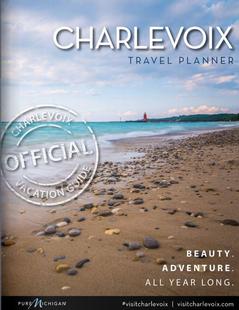Basics
- Length:
- 47 miles (75 km)
- Time:
- 60 minutes to drive the Byway one-way or 2-4 days to see the entire Byway.
- Fees:
- No fees are required to drive the Byway.
Description
On a rugged and rocky peninsula cradled by the frigid waters of Lake Superior lie the pieces of a story told, not in words, but in the landscape itself, in artifacts and buildings left from a mining past, in the remnants of a great transportation system, and the lives of the people here. The Copper Country Trail tells the story of a society that rose up out of the rock and forest as people of different cultures came together for a shared purpose. Make a trip to Michigan's Keweenaw Peninsula and experience the story for yourself.
"Go West, young man, go forth into the country!" Horace Greeley may have had the Keweenaw Peninsula in mind when he made this famous statement. He had visited the peninsula in 1831, and those that followed his call and came to the Copper Country found boomtowns, the largest pure copper deposits in the world, and a new start in America. Thousands of Irish, German, English, Scandinavian, and Italian immigrants came to work in the rapidly growing mining operations, making the Lake Superior Region a center for cultural diversity as well as industry. By the end of the 1840s the 'Copper Boom' had begun.
Get a sense of what it was like to be amongst the energy of the industrial complexes as you explore mineshaft buildings or historic lighthouses that served bustling ports transporting people and copper. The Keweenaw National Historical Park and its cooperating sites put the "story" back in history with sites, structures, and artifacts ranging from the Upper Peninsula Fire Fighter's Memorial Museum in the Calumet Unit of Keweenaw National Historical Park to the Laurium Manor Inn, a Victorian bed and breakfast. Descend deep into the earth on a tour of the Delaware Copper Mine and see pure veins of copper still exposed in the walls of the mine, or learn what army life was really like through the living history programs at Fort Wilkins State Park.
History buffs aren't the only ones that will enjoy a trip to the Keweenaw. Michigan's Upper Peninsula has long been a destination for those seeking adventure, relaxation, and an escape from the increasing pressures of urban life. Driving along the Copper Country Trail and its side trip routes, you'll catch glimpses of both picturesque wilderness and geological wonders. Feast your eyes on a ridge of ancient lava flows and the 1.6 billion-year-old bedrock arching out into the largest body of fresh water in the world. Or take time to enjoy the one of the nation's best mineral collections on display at the A. E. Seaman Mineral Museum.
Come away with a diversified experience rich in natural wonders and history when you travel the Copper Country Trail. Whether you have a week or only a weekend, you can find plenty to learn and do! Come to the Keweenaw; there's a story waiting for you here.
Helpful Links
Points of Interest
Points of Interest Along The Way
A. E. Seaman Mineral Museum (MI)
Established in 1902, the A. E. Seaman Mineral Museum is devoted to mineral science education and exhibition of fine mineral specimens. The museum is world renowned for its premier collection of Lake Superior copper district minerals, especially crystallized copper, silver, calcite, and datolite. Specimens from North America and around the world compliment this collection, totaling over 26,000 with 5,500 specimens on display. The museum is a Keweenaw National Historical Park Cooperating Site.
Directions
From the Portage Lake Lift Bridge, follow south-bound US-41 east out of Houghton on US-41 for two miles to the campus of Michigan Technological University. The museum is located on the 5th floor of the Electrical Engineering Resources Center in the middle of campus.
Bammert Blacksmith Shop (MI)
In an age when horse-drawn carriages were the principal means of land transportation, blacksmiths were important men, particularly to a booming mining community. Born in 1863, Amos Bammert first built his blacksmith shop near Cliff Mine during the 1880s. In 1906, the mine was moved to Phoenix, and Amos continued to work his trade there until his death in 1940.
The blacksmithing tools, including the forge, were left practically untouched when the business closed its doors, and in 1998 Amos Bammert's grandons donated the property to the Keweenaw County Historical Society. The society has restored the buildings' interior and exterior, and visitors will find the shop and equipment just as they would have been at the end of the nineteenth century.
Brockway Mountain Drive (MI)
A nine mile scenic drive that runs atop the spine of Brockway Mountain, the Brockway Scenic Drive has been a favorite of visitors since its construction by the Works Project Administration (WPA) and Civilian Conservation Corps (CCC) in 1933. Featuring stonework walls and spectacular views of Lake Superior and the landscape to the south of the Mountain, the Drive is a prime example of work done by the WPA/CCC crews, and helps tell the story of their role in the Keweenaw. Take the opportunity to view fall colors or a sunset over Lake Superior. On a clear day you can even see Isle Royale, 56 miles away, from the top of Brockway Mountain.
Directions
From Copper Harbor, take M-26 west for one mile and turn left onto Brockway Mountain, Drive.
Central Mine (MI)
A village that was once the site of one Keweenaw's most successful mines, Central, or Central Mine is one of the most important historical cites in Keweenaw County. Opened in 1854, the mine produced close to 52 million pounds of copper before closing for good in 1898. Keweenaw County Historical Society administers the site and has worked to restore many old miners' homes still standing on the old site. A visitors center soon provide interpretive exhibits not only about the mine but also about the miners' families, homes, schools and churches.
Another noteworthy feature of Central Village is the old Methodist Episcopal Church where descendants of the town's original inhabitants have gathered each year since 1907 on the last Sunday in July to pay tribute to all the pioneers that worked in the early copper mines that dotted Keweenaw County. Built in 1868 and closed in 1903, the church reflects the Cornish ancestry of many area residents in its distinctive battlemented tower.
Directions
Located 4 miles along the route.
Copper Harbor Lighthouse (MI)
The Copper Harbor Lighthouse, a round tower begun in 1848 and put into operation the folowing year, was replaced in 1866 by the present building. The 1848 lightkeeper's dwelling opened to the public in 1998. The Lighthouse area includes historic buildings, various lights used through the past one and a half centuries, and a walking trail. The Copper Harbor Lighthouse Complex is part of Fort Wilkins State park and is only accessible by boat.
Directions
1 mile from Copper Harbor at the end of the Byway.
Delaware Copper Mine (MI)
One of the earliest copper mines in the area, the Delaware Copper Mine operated from 1847 to 1887 and extracted approximately 8 million pounds of copper from the site. The mine has been preserved as it was when it closed its doors. Opened in 1977 the Delaware Copper Mine Tour is one of the area's longest established tourist attractions.
Directions
Located 16 miles along the Byway, 1/4 mile north of US 41.
Eagle Harbor Lighthouse and Museums (MI)
The Eagle Harbor Lighthouse was originally built in 1851 to provide navigational assisstance to the ships necessary to the booming copper industry on the Keweenaw Peninsuala. In 1871 the original wooden tower was replaced by the current red brick, and over the years improvements continued to be made to the structure. In 1895, for example, a fog signal was added, and in 1968 the original lens was replaced by modern red and white lights like those used in aviation which could be seen by ships more than 20 miles away!
In 1980, After 129 years and 21 different lighthouse keepers, the Eagle Harbor Lighthouse became automated. The Keweenaw County Historical Society has maintained museums on the site since 1982 and was granted ownership of the lightstation by congress in 1999. Today, the Lighthouse Complex in Eagle Harbor includes three museums: the Maritime Museum in the old fog signal building, the Copper Mining Museum including local/domestic history exhibits in the garage buildings, and a Commercial Fishing Museum in the assistant lightkeeper’s house.
Directions
From Phoenix, follow M-26 to Eagle Harbor and take Lighthouse Road to the lighthouse complex site.
Fort Wilkins State Park and Historic Complex (MI)
Fort Wilkins was once an active U.S. Army base built to keep peace in Michigan's Copper Country. Begun in 1844 and abandoned just two years later, the fort was briefly re-garrisoned in the late 1860s. Today, Fort Wilkins is a well preserved example of mid-19th Century army life on the northern frontier. Nineteen buildings survive, twelve of them original structures from the 1840s. The Park also includes the Copper Harbor Lighthouse Complex, accessible by boat.
Through Fort Wilkins' exhibits, audio/visual programs and living history interpretation, visitors may explore the daily routine military service. Visitors can learn to experience with the soldiers families the hardships of frontier isolation and discover the lifeways of another era.
Directions
Drive east out of Copper Harbor on US-41 for one mile to the Fort Wilkins Historic State Park.
Hanka Homestead (MI)
Many Finnish immigrants worked in the mines until they could afford to buy or homestead a small, self-sufficient farm. The Hanka Homestead is a small, largely unaltered 1920s Finnish farmstead with furniture, dishes, tools, and farm equipment reflective of the period. A log house, barns, sauna, milk house, root cellar, and other outbuildings sit on the 40-acre farmstead and remind visitors of an earlier age when pioneers carved out a living in the midst of the forest.
Directions
From the City of Houghton drive 18 miles south on US-41 to Arnheim Road. Follow signs to the homestead (about 6 miles). It is located well off the beaten path in its original setting.
Houghton County Historical Museum (MI)
Home of the Copper Country Railroad Heritage Center, and the former site of the largest copper milling operation in North America. The museum itself is the old C & H mill office. The Historical Society preserves, presents, and interprets the history and culture of Houghton County, emphasizing copper mining, processing, and transportation. The site includes a working one-mile loop, small-gauge railroad with original engine and mill site interpretive signs along a walking path.
Directions
Drive 10 miles east/north on M-26 from the Portage Lake Lift Bridge. The museum and train loop are on the east side of M-26. Or, from Calumet you can drive west/south on M-26 for 6.5 miles to the site.














